新编大学实用英语教程第二册Unit 6生词讲解
- 格式:pptx
- 大小:1.27 MB
- 文档页数:23
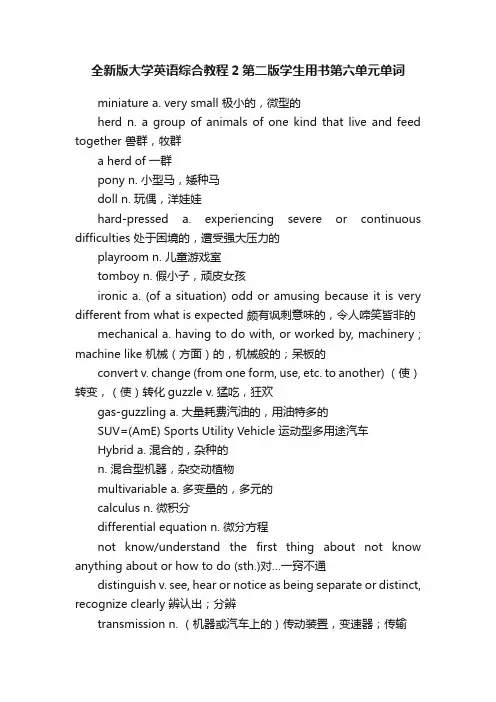
全新版大学英语综合教程2第二版学生用书第六单元单词miniature a. very small 极小的,微型的herd n. a group of animals of one kind that live and feed together 兽群,牧群a herd of 一群pony n. 小型马,矮种马doll n. 玩偶,洋娃娃hard-pressed a. experiencing severe or continuous difficulties 处于困境的,遭受强大压力的playroom n. 儿童游戏室tomboy n. 假小子,顽皮女孩ironic a. (of a situation) odd or amusing because it is very different from what is expected 颇有讽刺意味的,令人啼笑皆非的mechanical a. having to do with, or worked by, machinery ; machine like 机械(方面)的,机械般的;呆板的convert v. change (from one form, use, etc. to another) (使)转变,(使)转化guzzle v. 猛吃,狂欢gas-guzzling a. 大量耗费汽油的,用油特多的SUV=(AmE) Sports Utility Vehicle 运动型多用途汽车Hybrid a. 混合的,杂种的n. 混合型机器,杂交动植物multivariable a. 多变量的,多元的calculus n. 微积分differential equation n. 微分方程not know/understand the first thing about not know anything about or how to do (sth.)对…一窍不通distinguish v. see, hear or notice as being separate or distinct, recognize clearly 辨认出;分辨transmission n. (机器或汽车上的)传动装置,变速器;传输alternator n. 交流发电机mechanic a. person whose job is to repair and maintain machines 机修工;技工opener n. 开启工具;开瓶器,开罐器not know any better(used to say that someone does sth., bad or stupid because they have not been told that it is wrong)因无知而做错事情或干傻事crave v. feel a powerful desire for 渴望得到decent a. good enough; socially acceptable 像样的,相当好的;得体的can't help doing be unable to prevent oneself from doing 忍不住要做某事shudder v. shake uncontrollably; tremble with fear or disgust 战栗,(因恐惧或厌恶而)发抖at a disadvantage in a situation where one is less likely to succeed because of a problem 处于不利地位when it comes to when the subject being discussed is (a particular thing) 一谈到,就…而言imply v. express indirectly, suggest 暗示,含有……的意思abnormal a. different, often in an undesirable way, from what is normal, or expected 不正常的,变态的stumble v. hit your foot against sth. when walking; walk unsteadily 绊了一下,跌跌撞撞而行stumble into enter by accident 偶然步入grit v. 咬紧grit one's teeth press one's teeth together tightly in anger or determination 咬紧牙关;下定决心algebra n. 代数indication n. a sign that shows sth. exists, is true, or will happen 迹象,表示retake v. take again 重(考),补(考)panic n. sudden uncontrollable fear or anxiety 惊慌,恐慌v. 惊慌失措buzz v.,n. (make)a continuous sound like bees (作)嗡嗡声fluorescent a. 发荧光的fluorescent light 荧光灯,日光灯estrogen n. 雌激素thermodynamics n. 热力学femininity n. qualities that are considered typical of women 女性气质faulty a. mistaken or misleading because of flaws; defective 有缺陷的premise n. a previous statement from which another follows as a conclusion 前提cultural a. relating to the culture of a particular society, group or country 文化(上)的infant n. a very young child 婴儿;幼儿videogame n. 电子游戏incredibly adv. extremely, unusually 极其,非同一般地incredible a. surprising or hard to believe 令人惊讶的,难以置信的flexible a. able to change or be changed to suit new needs or conditions; able to bend or be bent easily 灵活的;有弹性的leap n.,v. (a sudden) jump 跳;跃a leap of faith sth. you do even though it involves a risk, hoping that it will have a good result 冒险一试selective a. tending to choose carefully 仔细挑选的,有选择的。

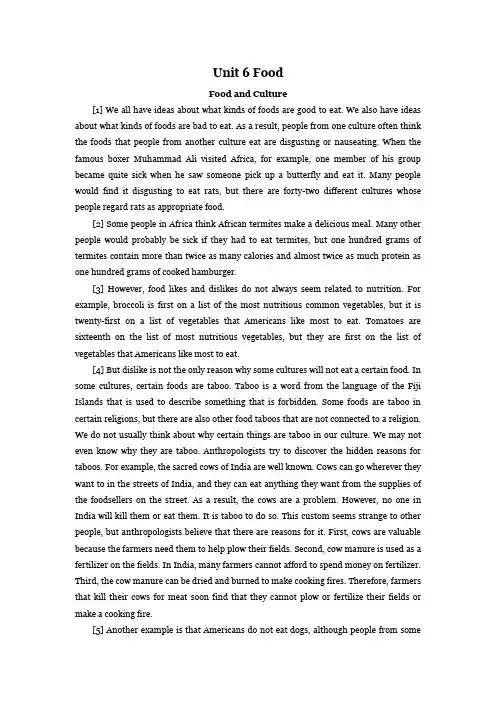
Unit 6 FoodFood and Culture[1] We all have ideas about what kinds of foods are good to eat. We also have ideas about what kinds of foods are bad to eat. As a result, people from one culture often think the foods that people from another culture eat are disgusting or nauseating. When the famous boxer Muhammad Ali visited Africa, for example, one member of his group became quite sick when he saw someone pick up a butterfly and eat it. Many people would find it disgusting to eat rats, but there are forty-two different cultures whose people regard rats as appropriate food.[2] Some people in Africa think African termites make a delicious meal. Many other people would probably be sick if they had to eat termites, but one hundred grams of termites contain more than twice as many calories and almost twice as much protein as one hundred grams of cooked hamburger.[3] However, food likes and dislikes do not always seem related to nutrition. For example, broccoli is first on a list of the most nutritious common vegetables, but it is twenty-first on a list of vegetables that Americans like most to eat. Tomatoes are sixteenth on the list of most nutritious vegetables, but they are first on the list of vegetables that Americans like most to eat.[4] But dislike is not the only reason why some cultures will not eat a certain food. In some cultures, certain foods are taboo. Taboo is a word from the language of the Fiji Islands that is used to describe something that is forbidden. Some foods are taboo in certain religions, but there are also other food taboos that are not connected to a religion. We do not usually think about why certain things are taboo in our culture. We may not even know why they are taboo. Anthropologists try to discover the hidden reasons for taboos. For example, the sacred cows of India are well known. Cows can go wherever they want to in the streets of India, and they can eat anything they want from the supplies of the foodsellers on the street. As a result, the cows are a problem. However, no one in India will kill them or eat them. It is taboo to do so. This custom seems strange to other people, but anthropologists believe that there are reasons for it. First, cows are valuable because the farmers need them to help plow their fields. Second, cow manure is used as a fertilizer on the fields. In India, many farmers cannot afford to spend money on fertilizer. Third, the cow manure can be dried and burned to make cooking fires. Therefore, farmers that kill their cows for meat soon find that they cannot plow or fertilize their fields or make a cooking fire.[5] Another example is that Americans do not eat dogs, although people from someother cultures regard them as good food. In the United States, dogs are very important to people as pets. They are usually regarded as part of the family, almost like a child in some cases. In addition, dogs have value as protection against criminals. Thieves will not usually enter a house where there is a dog because the dog will bark and possibly attack a stranger who is trying to get into a house. Apparently, the dog's place in society as a companion and as protection against criminals makes the dog taboo as food.[6] The taboo against eating pork occurs in more than one culture. There is some evidence that some ancient Egyptians did not eat pork. The ancient Israelites also regarded pork as taboo. One explanation for the pig-eating taboo is that pork that is not cooked sufficiently may spread a disease called trichinosis. However, most people no longer think that this is a good explanation for the pork taboo. Another explanation is that the Israelites were nomads—they were always moving from place to place. People have to stay in one place to raise pigs. The Israelites did not want to stay in one place because they did not want to change their culture. As a result, they did not eat pigs.[7] Anthropologists believe that most food likes and dislikes are a result of the ways of life of different people. Some people live in areas where there are both large animals and many insects. It is difficult for these people to kill large animals, and it requires a lot of energy. It is easier for them to use insects for food because it is not difficult to catch insects and it does not require a lot of energy. Nomadic people who move around will not want to keep pigs for food. People will not eat pets such as dogs. Americans eat a lot of beef because there is plenty of land for raising cattle and their meat can be shipped cheaply for long distances by railroads.饮食与文化1 对于什么样的食物好吃,我们都有自己的主见。
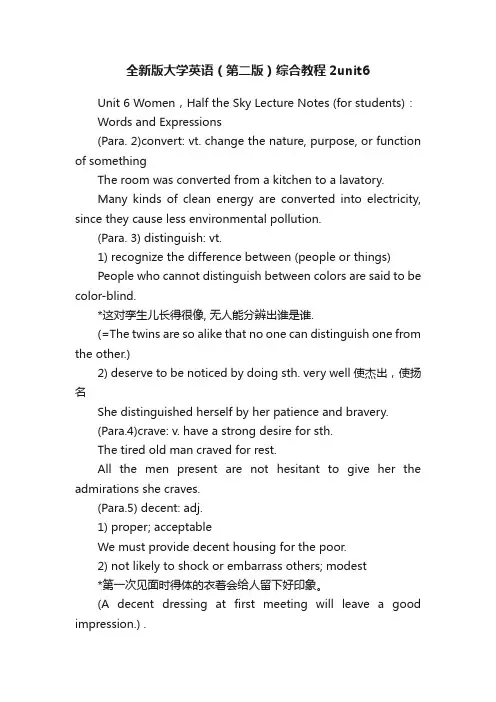
全新版大学英语(第二版)综合教程2unit6Unit 6 Women,Half the Sky Lecture Notes (for students):Words and Expressions(Para. 2)convert: vt. change the nature, purpose, or function of somethingThe room was converted from a kitchen to a lavatory.Many kinds of clean energy are converted into electricity, since they cause less environmental pollution.(Para. 3) distinguish: vt.1) recognize the difference between (people or things)People who cannot distinguish between colors are said to be color-blind.*这对孪生儿长得很像, 无人能分辨出谁是谁.(=The twins are so alike that no one can distinguish one from the other.)2) deserve to be noticed by doing sth. very well 使杰出,使扬名She distinguished herself by her patience and bravery.(Para.4)crave: v. have a strong desire for sth.The tired old man craved for rest.All the men present are not hesitant to give her the admirations she craves.(Para.5) decent: adj.1) proper; acceptableWe must provide decent housing for the poor.2) not likely to shock or embarrass others; modest*第一次见面时得体的衣着会给人留下好印象。

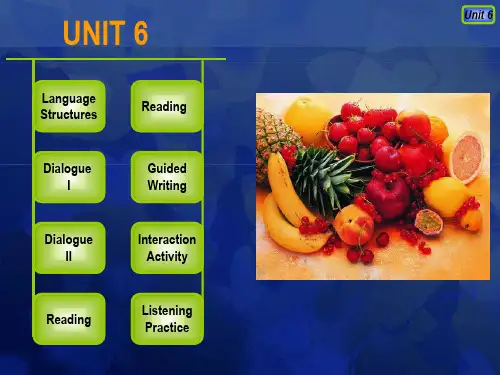
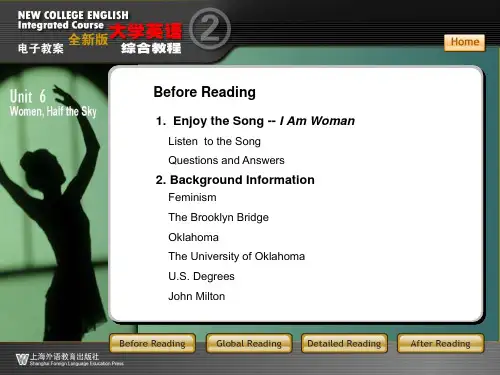
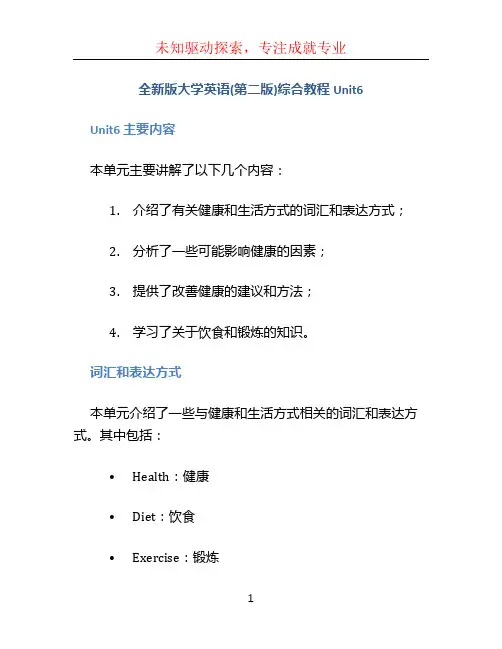
全新版大学英语(第二版)综合教程Unit6Unit6 主要内容本单元主要讲解了以下几个内容:1.介绍了有关健康和生活方式的词汇和表达方式;2.分析了一些可能影响健康的因素;3.提供了改善健康的建议和方法;4.学习了关于饮食和锻炼的知识。
词汇和表达方式本单元介绍了一些与健康和生活方式相关的词汇和表达方式。
其中包括:•Health:健康•Diet:饮食•Exercise:锻炼•Lifestyle:生活方式•Nutrition:营养•Balanced diet:均衡饮食•Sedentary lifestyle:久坐不动的生活方式•Stress:压力•Relaxation techniques:放松技巧•Body mass index (BMI):身体质量指数通过学习这些词汇和表达方式,我们可以更好地理解和讨论有关健康和生活方式的话题。
影响健康的因素在本单元中,我们分析了一些可能影响健康的因素。
这些因素包括:1.饮食:不良的饮食习惯可能导致肥胖、营养不良等健康问题;2.锻炼:缺乏锻炼可能导致肌肉萎缩、心血管问题等;3.生活方式:久坐不动、吸烟、过度饮酒等生活方式可能对健康产生负面影响;4.压力:过度压力可能导致焦虑、抑郁等心理健康问题。
了解这些因素对我们改善健康和采取相应措施至关重要。
通过调整饮食习惯、增加运动、减少不良生活方式、学会应对压力等,我们可以更好地保持健康。
改善健康的建议和方法本单元提供了一些有关改善健康的建议和方法。
以下是一些常见的建议:1.均衡饮食:合理搭配各类食物,确保摄入足够的营养;2.多锻炼:每天进行适度的有氧运动,如散步、跑步等;3.拒绝久坐:经常起身活动,做一些运动伸展;4.戒烟限酒:戒掉吸烟习惯,限制饮酒量;5.学会放松:使用一些放松技巧缓解压力,如冥想、呼吸练习等。
通过采取这些改善健康的建议和方法,我们可以提高身体和心理的健康水平,并享受更好的生活质量。
饮食和锻炼的知识在本单元中,我们还学习了一些关于饮食和锻炼的知识。
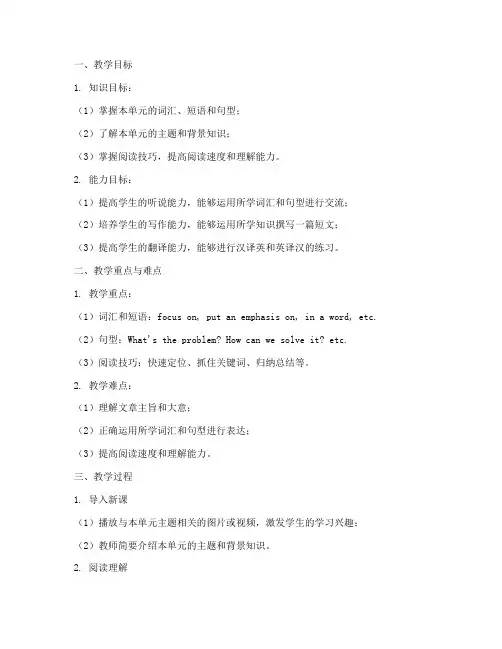
一、教学目标1. 知识目标:(1)掌握本单元的词汇、短语和句型;(2)了解本单元的主题和背景知识;(3)掌握阅读技巧,提高阅读速度和理解能力。
2. 能力目标:(1)提高学生的听说能力,能够运用所学词汇和句型进行交流;(2)培养学生的写作能力,能够运用所学知识撰写一篇短文;(3)提高学生的翻译能力,能够进行汉译英和英译汉的练习。
二、教学重点与难点1. 教学重点:(1)词汇和短语:focus on, put an emphasis on, in a word, etc.(2)句型:What's the problem? How can we solve it? etc.(3)阅读技巧:快速定位、抓住关键词、归纳总结等。
2. 教学难点:(1)理解文章主旨和大意;(2)正确运用所学词汇和句型进行表达;(3)提高阅读速度和理解能力。
三、教学过程1. 导入新课(1)播放与本单元主题相关的图片或视频,激发学生的学习兴趣;(2)教师简要介绍本单元的主题和背景知识。
2. 阅读理解(1)让学生快速浏览文章,了解文章大意;(2)教师引导学生分析文章结构,找出文章主题句;(3)针对文章中的难句和重点词汇进行讲解,帮助学生理解文章内容;(4)让学生完成阅读练习,巩固所学知识。
3. 词汇学习(1)教师带领学生复习本单元的词汇,并举例说明;(2)让学生运用所学词汇进行造句,提高词汇运用能力。
4. 听力训练(1)播放与本单元主题相关的听力材料,让学生进行听力训练;(2)教师讲解听力技巧,帮助学生提高听力水平;(3)让学生完成听力练习,巩固所学知识。
5. 口语表达(1)教师组织学生进行口语对话,让学生运用所学词汇和句型进行交流;(2)教师进行点评和指导,提高学生的口语表达能力。
6. 写作训练(1)教师给出写作话题,让学生运用所学知识进行写作;(2)教师进行点评和指导,提高学生的写作能力。
7. 总结与布置作业(1)教师对本节课的学习内容进行总结,强调重点和难点;(2)布置课后作业,包括阅读、听力、词汇、口语和写作练习。
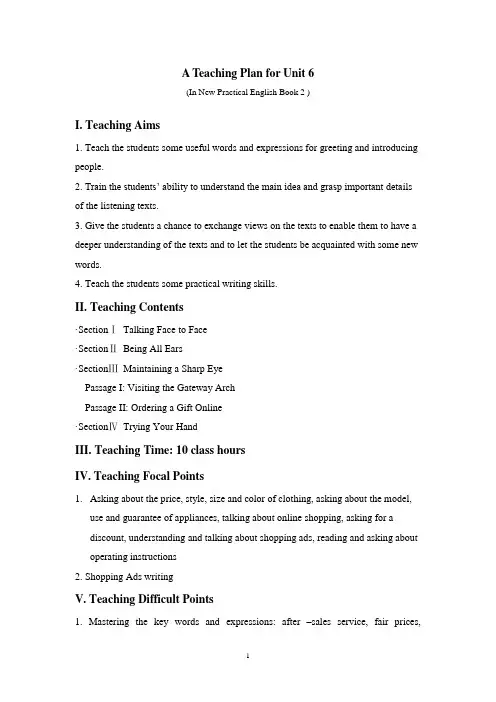
A Teaching Plan for Unit 6(In New Practical English Book 2 )I. Teaching Aims1. Teach the students some useful words and expressions for greeting and introducing people.2. Train the students’ ability to understand the main idea and grasp important deta ils of the listening texts.3. Give the students a chance to exchange views on the texts to enable them to have a deeper understanding of the texts and to let the students be acquainted with some new words.4.Teach the students some practical writing skills.II. Teaching Contents·SectionⅠTalking Face to Face·SectionⅡBeing All Ears·SectionⅢMaintaining a Sharp EyePassage I: Visiting the Gateway ArchPassage II: Ordering a Gift Online·SectionⅣTrying Your HandIII. Teaching Time:10 class hoursIV. Teaching Focal Points1.Asking about the price, style, size and color of clothing, asking about the model,use and guarantee of appliances, talking about online shopping, asking for adiscount, understanding and talking about shopping ads, reading and asking about operating instructions2. Shopping Ads writingV. Teaching Difficult Points1. Mastering the key words and expressions: after –sales service, fair prices,handicrafts, souvenir, galleries, wonderful, fantastic, magnificent, surpass, be equipped with, install, purchase, alternative, surf, dismayed, upon (on) inspection, pop up, login browse.2. Grammar----Present participle and past participle as attributivIV. Teaching methodsInteractive approachSituational teaching approachTeamwork methodTask-based teaching methodVII. Teaching aidsPPTBlackboardVIII. Teaching Procedure1.The first two-class-hour session for SectionⅠTalking Face to Face.2.Next two-class-hour session for SectionⅡBeing All Ears.3.The next four-class-hour session for SectionⅢMaintaining a Sharp Eye.4.The fifth two-class-hour session for Section ⅣTrying Your Hand.Section I Talking Face to Face1. Read the samplesFind out useful expressions for shopping and sightseeing.Sentences used for shopping:①. Do you have anything particular in mind?②. How do you like this ring?③. What brand do you need, please?④. Can I try them on?⑤. Take your time.⑥. May I have a look at that coat?Sentences used for sightseeing:①. So it was a really wonderful trip.②. How was your trip to London?③. There are so many places to go to and events to see.④. What do you think is the best time to go there?⑤. I’ve always dreamed of going to see some magnificent sites in Australia. Practice the following sentences:①. You can find some real Chinese souvenirs here.②. Would you like to look at the jewels?③. I’d like a pair of leather shoes, something like the style I am wearing, please.④. I think I will buy it for my wife.⑤. I just want something of food quality.⑥. The art galleries in Paris were fantastic⑦. Louvre is really amazing.⑧. I want to see the famous Sydney Opera House and take photos from Harbor Bridge⑨. I hope I can go swimming and surfing in the best surf in the Pacific.⑩. Which city do you like better, Paris or London?2. Act outRole playThe students role-play the similar situations of communication they have created, first in groups, and them to the class.Section II Being All Ears1. DialoguePre-listening taskRead the printed materials in Listen and Decode in ONE minute.While-listening task①. Listen to the tape WITHOUT looking at the book.②. Listen to the tape one sentence after another, taking notes during the pause.③. Repeat the sentences after the tape.Dialogue scriptShop assistant: Good afternoon, sir. What can I do for you?Mr. Anderson: Can you show me some silk, real Chinese silk?Shop assistant: Certainly. How do you like this design?Mr. Anderson: Have you got anything brighter? Something more Chinese?Shop assistant: How about the design with blue and yellow birds? It’s a traditional design and the colors are bright.Mr. Anderson: Oh, it’s lovely and very Chinese. Is it pure silk?Shop assistant: Yes, one hundred percent pure silk.Mr. Anderson: How much do I need for a short-sleeved dress? It’s for my daughter. She’s about my height.Shop assistant: I think one and a half meters would be enough.Mr. Anderson: All right. Please let me have one and a half meters then.Shop assistant: That will be one hundred and forty yuan.Post-listening taskDo the exercises in Listen and Decode and Listen and Respond.2. PassagePre-listening taskRead the printed materials in Listen and Read in THREE minutes.While-listening task①. Listen to the tape and fill in the blanks.②. Listen again and check up the answers.Answers:1. three2. films3. on a beautiful beach4. Beijing5. going to Beijing6. lively and exciting7.a boat tripPost-listening taskDo the exercises in Listen and Match and Listen and Conclude.3.Assignments①. Pair work: Make up dialogues about shopping and sightseeing in pairs, referring to the dialogues in the Workbook.②. Preview Passage I and do the exercises.Section IIIPassage I Visiting the Gateway Arch1. Warm-up questions①. What do you know about America’s mountains and famous buildings?②. What is the tallest man-made monument in the Western Hemisphere? References:①. The statue of Liberty, the Washington Monument, Empire State Building, etc.②. The Gateway Arch.2. Reading comprehensionA) Background Knowledge:The Gate way ArchThe Gate way Arch is part of an entire project, which was to fulfill two goals. One, to make it economically feasible to redevelop a significant, blighted riverfront area in St. Louis. Two, to commemorate Thomas Jefferson, the Louisiana Purchase, and westward expansion. The Jefferson National Expansion Memorial is the result of these goals. The design for the Gateway Arch itself, intended to be the centerpiece of the memorial, came out of an international competition in the late 1940s. Eero saarinen, a Finnish-American architect, provided the winning plan. The actual construction commenced on June 27, 1962 with the first pouring of what would ultimately be 26 000 tons of concrete for the bases of the two triangular legs. The final section of the structure was put into place almost exactly 40 months later, on October 28, 925.B) Questions:Question 1: What can we learn from the first paragraph?Question 2: How high is the Gateway Arch?Question 3: How can we get to the top of the Gateway Arch?Question 4: Where can you get a tram ticket?Question 5: How many days do the arch trams run every week?C) Summary:Summarize the basic information of the Gateway Arch.3. Useful words and expressions①. surpass: to do or be better thane.g. The book’s success has surpassed everyone’s expectation.②. be equipped with: to provide (someone or something) with objects that are needed for a particular activity or purposee.g. All of our classrooms are equipped with computers.③. install: put furniture, a machine or a piece of equipment into position and make it ready to usee.g. The plumber is coming tomorrow to install the new washing machine.④. purchase: to buy something big or expensivee.g. Employees are encouraged to purchase shares in the firm.⑤. alternative: something that is different, esp. from what is usual; a choicee.g. People stay because they don’t have alternative opportunities.4. Difficult Sentences①. The Arch is over twice as tall as the Statue of Liberty.The newly-built street is twice as wide as the old one.②. The Arch surpassed Egypt’s Great Pyramid (450 ft) in height.The Nile measures 6 695 kilometers in length.③. Your trip to the top of the gateway arch begins when you purchase a ticket at the TRAM TICKET WINDOW.Your sightseeing of the beautiful city begins when you purchase a ticket for takinga sightseeing car.④. During peak seasons, a trip to the top leaves every five minutes.Off-seasons trams operate every ten to twenty minutes.⑤. The north and south tram each consists of eight barrel-shaped capsulesThe bill comes to $ 80, so that’s $ 20 each.⑥. Tickets available at ticket windows.Spades available in the store house.5. Assignments①. Recite the first paragraph of Passage I.②. Preview Passage II and do exercises of Passage I.Passage II Ordering a Gift Online1.Warm-up activity1)Warm-up questions①.Have you ever done shopping online?②. Are there any advantages of online shopping?2). Reading aloud practiceThe students read the passage twice (once in groups, and once individually)3). Class discussionThe teacher asks questions about the main idea of the passage and the students read the passage and give their answers to the teacher’s questions.Question 1: Whom did the author want to find a gift for?Question 2: What did the author find about online transaction?Question 3: How much was the shipping charge for a $ 25 bonsai tree?Question 4: What did the author finally order?4). Word consolidationThe students pick up the words and expressions related to the internet from the passage:Surf the web/ search engine/ graphic/ website/ browse2. Read the passage and do Exercise73. Useful words and expressions①. surf: spend time visiting websitese.g. Many towns and cities have cybercafés where you can surf the Internet/Net/ Web.②. dismayed: feeling surprised and unhappye.g. They enjoyed the meal but were dismayed by its high cost.③. upon (on) inspection: looking at something carefullye.g. Her passport seemed all right, but on closer inspection, it was found to have been altered..④. pop up: appear or happen, especially suddenly or unexpectedlye.g. She’s one of those film stars who pop up everywhere, on TV, in magazines, in newspapers.⑤. log in: put your name into a computer so that you can start using ite.g. Before using the Internet, you should log in your name and password.⑥. browse: to look at a piece of information on the Internete.g. to browse the World Wide Web4. AssignmentsDo the left exercises of Passage IISection IV Writing----Instructions1. Sample analysis1) Format analysisOperating Instructions are usually attached to a technical device to explain how to install or operate it. Take Sample 1 as an example for the analysis. The questions are:①. What is the model of the product?②. What features does the player have?③. What are the dimensions and weight of the player?④. How large is the memory of the player?⑤. What comes with the player?2)Language features①. Identify the technical terms in the instructions.②. Find the positive expressions used to describe the product.2. Additional samplesHitachi Develops a Robot that has the Capabilities for Daily life and that Moves in Response to Dialogs with People.Hitachi, Ltd. announced that it has developed a robot-called “EMIEW”- for supporting people’s everyday life. EMIEW has such physical capabilities as agile movement and obstacle avoidance, needed for real life, and it can move around while interacting in dialog with humans from a distance of one meter without the need for microphones. The technologies developed for EMIEW will lead the way in creating robots of the future that can cooperate and coexist with humans.EMIEW is 130 cm tall and weights approximately 70 kg; his arms have 6 degrees of freedom.Moreover, the mane “EMIEW”(Excellent Mobility and Interactive Existence as Workmate) refers to a robot that acts like a workmate through dialog interactions from people and its agile movements.The main features of EMIEW are:①. High-speed and agile movement②. Ability to get around obstructions: Collision avoidance③. Recognition of voices and sounds from a distance④. Natural arm movement like a human3. AssignmentsDo the Simulate and Create exercises.Section V Grammar----Present participle and past participle as attributivesEnglish verbs have two participles:called variously the present, active, imperfect, or progressive participle, it is identical in form to the gerund; the term present participle is sometimes used to include the gerund. The term gerund-participle is also used.called variously the past, passive, or perfect participle, it is usually identical to the verb's preterite (past tense) form, though in irregular verbs the two usually differ. Examples of participle formation include:The present participle in English is active. It has the following uses:forming the progressive aspect: Jim was sleeping.modifying a noun, with active sense: Let sleeping dogs lie.modifying a verb or sentence: Broadly speaking, the project was successful.The present participle in English has the same form as the gerund, but the gerund acts as a noun rather than a verb or a modifier. The word sleeping in your job description does not include sleeping is a gerund and not a present participle.The past participle has both active and passive uses:forming the perfect aspect: The chicken has eaten.forming the passive voice: The chicken was eaten.modifying a noun, with active sense: our fallen comradesmodifying a noun, with passive sense: the attached filesmodifying a verb or sentence, with passive sense: Seen from this perspective, the problem presents no easy solution.As noun-modifiers, participles usually precede the noun (like adjectives), but in many cases they can or must follow it:The visiting dignitaries devoured the baked apples.Please bring all the documents required.The difficulties encountered were nearly insurmountable3. AssignmentsDo the grammar exercises in the Workbook.。
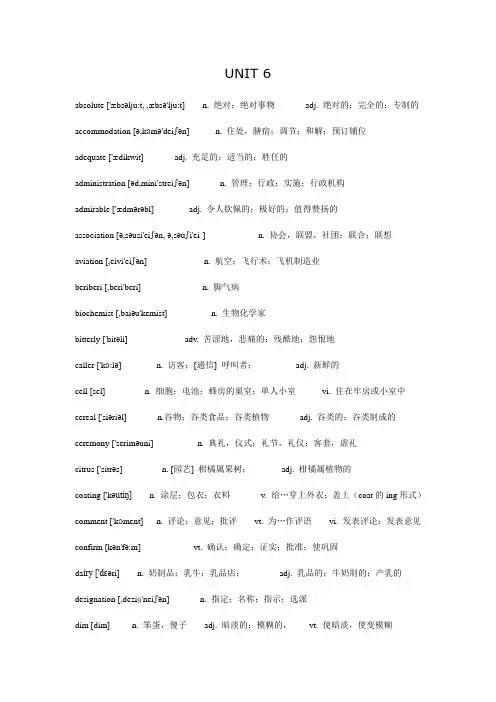
UNIT 6absolute ['æbsəlju:t, ,æbsə'lju:t] n. 绝对;绝对事物adj. 绝对的;完全的;专制的accommodation [ə,kɔmə'deiʃən] n. 住处,膳宿;调节;和解;预订铺位adequate ['ædikwit] adj. 充足的;适当的;胜任的administration [əd,mini'streiʃən] n. 管理;行政;实施;行政机构admirable ['ædmərəbl] adj. 令人钦佩的;极好的;值得赞扬的association [ə,səusi'eiʃən, ə,səuʃi'ei-] n. 协会,联盟,社团;联合;联想aviation [,eivi'eiʃən] n. 航空;飞行术;飞机制造业beriberi [,beri'beri] n. 脚气病biochemist [,baiəu'kemist] n. 生物化学家bitterly ['bitəli] adv. 苦涩地,悲痛的;残酷地;怨恨地caller ['kɔ:lə] n. 访客;[通信] 呼叫者;adj. 新鲜的cell [sel] n. 细胞;电池;蜂房的巢室;单人小室vi. 住在牢房或小室中cereal ['siəriəl] n.谷物;谷类食品;谷类植物adj. 谷类的;谷类制成的ceremony ['seriməuni] n. 典礼,仪式;礼节,礼仪;客套,虚礼citrus ['sitrəs] n. [园艺] 柑橘属果树;adj. 柑橘属植物的coating ['kəutiŋ]n. 涂层;包衣;衣料v. 给…穿上外衣;盖上(coat的ing形式)comment ['kɔment] n. 评论;意见;批评vt. 为…作评语vi. 发表评论;发表意见confirm [kən'fə:m] vt. 确认;确定;证实;批准;使巩固da iry ['dεəri] n. 奶制品;乳牛;乳品店;adj. 乳品的;牛奶制的;产乳的designation [,deziɡ'neiʃən] n. 指定;名称;指示;选派dim [dim] n. 笨蛋,傻子adj. 暗淡的;模糊的,vt. 使暗淡,使变模糊employee [,emplɔi'i:, em'plɔii:] n. 雇员;从业员工fatty ['fæti] n. 胖子adj. 脂肪的;肥胖的;fortified ['fɔ:tifaid] v. 筑防御工事于…(fortify的过去式);adj. 加强的furnish ['fə:niʃ] vt. 提供;供应;装备goodness ['ɡudnis] int. 天哪;adj. 善良,优秀;精华,养分gymnast ['dʒimnæst] n. 体操运动员helicopter ['helikɔptə] n. [航] 直升飞机hygiene ['haidʒi:n] n. 卫生;卫生学;保健法identification [ai,dentifi'keiʃən] n. 鉴定,识别;认同;身份证明illustrate ['iləstreit] vt. 阐明,举例说明;图解inadequacy [in'ædikwəsi] n. 不适当,不充分;不完全;inconvenient [,inkən'vi:njənt] adj. 不便的;打扰的indistinct [,indis'tiŋkt]adj. 模糊的,不清楚的;朦胧的;injection [in'dʒekʃən] n. 注射;注射剂;充血;射入轨道insult [in'sʌlt] n. 侮辱;凌辱;无礼vt. 侮辱;辱骂;损害integrity [in'teɡrəti] n. 完整;正直;诚实;廉正intellectual [,intə'lektjuəl] n. 知识分子;adj. 智力的;聪明的;理智的interfere [,intə'fiə] vt. 冲突;介入vi. 干涉;妨碍;打扰interval ['intəvəl] n. 间隔;间距;幕间休息kidney ['kidni] n. [解剖] 肾脏;腰子;个性leafy ['li:fi] adj. 多叶的;叶状的;叶茂盛的lime [laim] n. 石灰;酸橙;绿黄色adj. 绿黄色的vt. 撒石灰于;涂粘鸟胶于liver ['livə] n. 肝脏;生活者,居民manufacture [,mænju'fæktʃə] n. 制造;产品;制造业vt. 制造;加工;捏造margarine [,mɑ:dʒə'ri:n] n. 人造黄油;人造奶油metabolic [,metə'bɔlik,-kəl] adj. 变化的;新陈代谢的misery ['mizəri] n. 痛苦,悲惨;不幸;苦恼;穷困moan [məun] n. 呻吟声;悲叹vt. 抱怨;呻吟着说vi. 抱怨,悲叹;呻吟novelist ['nɔvəlist] n. 小说家obtain [əb'tein, ɔb-] vt. 获得vi. 获得;流行oxidation [,ɔksi'deiʃən] n. [化学] 氧化pilot ['pailət] n. 飞行员;领航员adj. 试点的v. 驾驶;领航;试用pleading ['pli:diŋ]n. 恳求;答辩;辩论adj. 恳求的v. 辩护(plead的ing形式)polished ['pɔliʃt] adj. 擦亮的;优美的;圆滑的v. 擦亮(polish的过去式和过去分词)poultry ['pəultri] n. 家禽preliminary [pri'liminəri] n. 准备;预赛;初步措施adj. 初步的;开始的;预备的awarding n. 颁奖(award的现在时,动名词形式);获奖情况proof-reading n. 校对工作relieve [ri'li:v] vt. 解除,减轻;使不单调乏味;换…的班;解围;使放心remedy ['remidi] n. 补救;治疗;赔偿vt. 补救;治疗;纠正resident ['rezidənt] n. 居民adj. 居住的;住院医师;定居的retiree [ri,taiə'ri:] n. (美)退休人员;歇业者scurvy ['skə:vi] n. [内科] 坏血病adj. 卑鄙的,下流的seafarer ['si:fεərə] n. 船员;航海家smallpox ['smɔ:lpɔks] n. [内科] 天花soar [sɔ:] n. 高飞;高涨vi. 高飞;高耸;往上飞舞stroke [strəuk] n. 中风;冲程;笔画;打击;尝试;轻抚vt. 抚摸;敲击;划尾桨;划掉vi. 击球;作尾桨手;敲击键盘substance ['sʌbstəns] n. 物质;实质;资产;主旨surgical ['sə:dʒikəl] n. 外科手术;外科病adj. 外科的;手术上的thoroughly ['θʌrəli, 'θə:rəu-] adv. 彻底地,完全地tissue ['tiʃju:, -sju:] n. 纸巾;薄纱;一套vt. 饰以薄纱;用化妆纸揩去ultimately ['ʌltimətli] adv. 最后;根本;基本上uncharted [,ʌn'tʃɑ:tid] adj. 未知的;图上未标明的vaccinate ['væksineit] n. 被接种牛痘者vt. 给…注射疫苗vi. 接种疫苗vessel ['vesəl] n. 船,舰;[组织] 脉管,血管;容器,器皿vitamin ['vitəmin] n. [生化] 维生素;[生化] 维他命voyage ['vɔiidʒ] n. 航行;航程;旅行记vt. 飞过;渡过vi. 航行;航海Whole-grain 全谷物。
Unit 6 FoodFood and Culture[1] We all have ideas about what kinds of foods are good to eat. We also have ideasabout what kinds of foods are bad to eat. As a result, people from one culture often thinkthe foods that people from another culture eat are disgusting or nauseating. When the famous boxer Muhammad Ali visited Africa, for example, one member of his group became quite sick when he saw someone pick up a butterfly and eat it. Many people would find it disgusting to eat rats, but there are forty-two different cultures whose people regard rats as appropriate food.[2] Some people in Africa think African termites make a delicious meal. Many otherpeople would probably be sick if they had to eat termites, but one hundred grams of termites contain more than twice as many calories and almost twice as much protein asone hundred grams of cooked hamburger.[3] However, food likes and dislikes do not always seem related to nutrition. For example, broccoli is first on a list of the most nutritious common vegetables, but it is twenty-first on a list of vegetables that Americans like most to eat. Tomatoes are sixteenth on the list of most nutritious vegetables, but they are first on the list of vegetables that Americans like most to eat.[4] But dislike is not the only reason why some cultures will not eat a certain food. Insome cultures, certain foods are taboo. Taboo is a word from the language of the Fiji Islands that is used to describe something that is forbidden. Some foods are taboo in certain religions, but there are also other food taboos that are not connected to a religion.We do not usually think about why certain things are taboo in our culture. We may noteven know why they are taboo. Anthropologists try to discover the hidden reasons for taboos. For example, the sacred cows of India are well known. Cows can go wherever theywant to in the streets of India, and they can eat anything they want from the supplies ofthe foodsellers on the street. As a result, the cows are a problem. However, no one in India will kill them or eat them. It is taboo to do so. This custom seems strange to otherpeople, but anthropologists believe that there are reasons for it. First, cows are valuablebecause the farmers need them to help plow their fields. Second, cow manure is used as afertilizer on the fields. In India, many farmers cannot afford to spend money on fertilizer.Third, the cow manure can be dried and burned to make cooking fires. Therefore, farmersthat kill their cows for meat soon find that they cannot plow or fertilize their fields or make a cooking fire.[5] Another example is that Americans do not eat dogs, although people from someother cultures regard them as good food. In the United States, dogs are very important topeople as pets. They are usually regarded as part of the family, almost like a child in somecases. In addition, dogs have value as protection against criminals. Thieves will not usually enter a house where there is a dog because the dog will bark and possibly attack astranger who is trying to get into a house. Apparently, the dog's place in society as a companion and as protection against criminals makes the dog taboo as food.[6] The taboo against eating pork occurs in more than one culture. There is some evidence that some ancient Egyptians did not eat pork. The ancient Israelites also regarded pork as taboo. One explanation for the pig-eating taboo is that pork that is notcooked sufficiently may spread a disease called trichinosis. However, most people no longer think that this is a good explanation for the pork taboo. Another explanation is that the Israelites were nomads—they were always moving from place to place. People have to stay in one place to raise pigs. The Israelites did not want to stay in one place because they did not want to change their culture. As a result, they did not eat pigs.[7] Anthropologists believe that most food likes and dislikes are a result of the waysof life of different people. Some people live in areas where there are both large animalsand many insects. It is difficult for these people to kill large animals, and it requires a lotof energy. It is easier for them to use insects for food because it is not difficult to catchinsects and it does not require a lot of energy. Nomadic people who move around will notwant to keep pigs for food. People will not eat pets such as dogs. Americans eat a lot ofbeef because there is plenty of land for raising cattle and their meat can be shipped cheaply for long distances by railroads.饮食与文化1 对于什么样的食物好吃,我们都有自己的主见。
Useful Expressions in Unit 6,Book 2 (by Mr. Hu )1. bulletin: n. a short printed newspaper or leaflet, esp.one produced regularly by a group or organizationeg. the latest bulletin about the Premier's healthannual bulletin年度公报government bulletin政府公报, 官方公报information bulletin情报通(公)报news bulletin新闻公报statistical bulletin统计公报bulletin board布告牌2. innocent←→guilty innocence←→guilt3. item: n. 1)a single piece of newslocal items地方新闻eg.There was an interesting item in the newspaper today.2) a single article or unit on a list or among a setitem by item逐条, 逐项item on the agenda议程项目a shopping list with numerous items拥有大量条目的售货清单4. undo:v. 1).(fml.) disturb or upset greatlyeg. The news of your illness undid him.2). untie, openeg. His buttons were undone.她解开了绕在包裹上的绳子。
She undid the string round the parcel/packet/present.3). cause the ruin or downfall of; destroyeg. What is done cannot be undone. [谚]覆水难收(事已定局, 无可挽回)。
Useful Expressions in Unit 6,Book 2 (by Mr. Hu )1. bulletin: n. a short printed newspaper or leaflet, esp.one produced regularly by a group or organizationeg. the latest bulletin about the Premier's healthannual bulletin年度公报government bulletin政府公报, 官方公报information bulletin情报通(公)报news bulletin新闻公报statistical bulletin统计公报bulletin board布告牌2. innocent←→guilty innocence←→guilt3. item: n. 1)a single piece of newslocal items地方新闻eg.There was an interesting item in the newspaper today.2) a single article or unit on a list or among a setitem by item逐条, 逐项item on the agenda议程项目a shopping list with numerous items拥有大量条目的售货清单4. undo:v. 1).(fml.) disturb or upset greatlyeg. The news of your illness undid him.2). untie, openeg. His buttons were undone.她解开了绕在包裹上的绳子。
She undid the string round the parcel/packet/present.3). cause the ruin or downfall of; destroyeg. What is done cannot be undone. [谚]覆水难收(事已定局, 无可挽回)。
Unit 6 Women, Half the SkyText A A Woman Can Learn Anything a Man Can1.(Para. 2) ironic: adj. humorously sarcastic or mocking*我如此拼命要守住的这个秘密,却被他们这么漫不经心的对待.(=How ironic is it to have something I tried so desperately to keep secret treated so casually.)* It is sadly ironic that in these modern times it still takes weapons to prevent war. CF: sarcastic, satiric & ironic这三个词都是形容词, 都有“讽刺的”之意。
sarcastic 指运用讥讽的、嘲笑的(方法、方式)。
例如:Must you always be so sarcastic when I ask you anything?每当我问你时,你有必要总是这样嘲笑吗?satiric 指喜好讽刺的、含有讽刺的。
例如:Gulliver’s Travels is a satiric book.《格利弗游记》是一部讽刺小说。
ironic 指讽刺的、具有讽刺意味的。
例如:It was ironic that he should have been invited to play for the Scotland team on the very day that he broke his legs.具有讽刺意味的是他正好在跌断腿的那一天收到了要为苏格兰队踢球的邀请。
2. (Para. 2) convert: vt. change the nature, purpose, or function of something* The room was converted from a kitchen to a lavatory.(=Many kinds of clean energy are converted into electricity, since they cause less environmental pollution.)CF: reform, convert & revise这三个词都是动词,都有“改良”、“改变”之意。
Unit 6 Book 1Detailed ReadingI. Difficult Sentences1.He looked for the girl whose heart he knew, but whose face he didn’t, the girl with the rose.(Para. 2)1) Paraphrase the sentence.(He tried to find the girl who shared many of his views, interests and feelings but who he had never met before. The girl was supposed to wear a rose at their first meeting.)2) Translate the sentence into Chinese.(他在寻找一位姑娘,一位佩戴玫瑰的姑娘。
他知其心,但不知其貌。
)2.Each letter was a seed falling on a fertile heart. (Para. 4)Paraphrase the sentence.(Each letter from one would bring forth a warm response from the other as a seed falling on fertile soil is likely to grow into a plant.)3.I’d always be haunted by the feeling that you had been taking a chance on just that, and thatkind of love would disgust me. (Para. 4)1) Why is the past perfect continuous tense used in the sentence?(To show that this action took place earlier than “you fell in love with me on seeing my picture”.)2) Translate the sentence into Chinese.(我将会一直深感不安,惟恐你只是因为我的容貌就贸然与我相爱,而这种爱情令我憎恶。